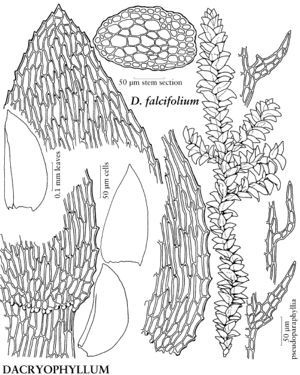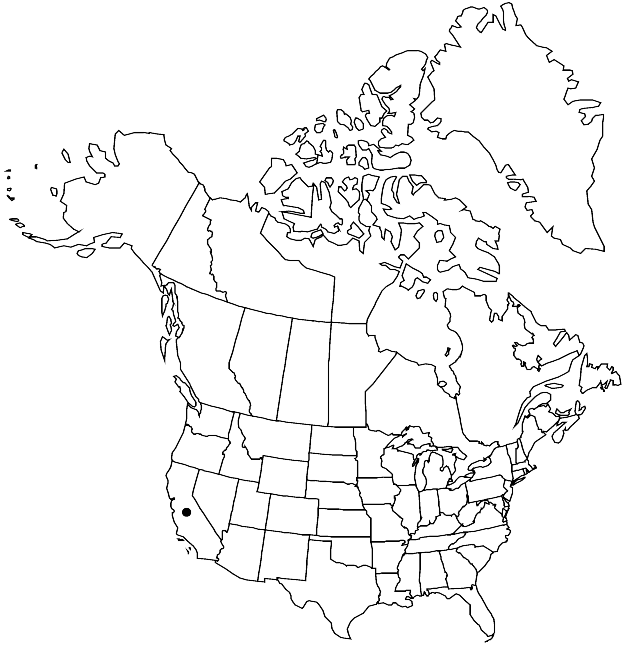Dacryophyllum falcifolium
Novon 14: 70, fig. 1. 2004.
Stems 1.5 cm, 0.8–1 mm wide, complanate-foliate; cortical cells in 2 or 3 rows, moderately small, walls thick, central cells large, walls thin; pseudoparaphyllia 2–4 cells wide, serrulate to toothed, sometimes with 1-celled, large teeth, usually mixed with entire pseudoparaphyllia, 3–6 cells in length; rhizoids few, on ventral surface of stems and branches, single or in clusters just proximal to leaf insertion, smooth; axillary hairs 108 µm, usually in axils of distal leaves near apical bud, basal cell 1, distal cells 1 or 2. Leaves stiff, asymmetric, not concave, 0.3–0.5 × 0.1–0.2 mm; marginal serrations often formed by 2 abutting basal cells; apex falcate; alar cells 8–19 × 6–7 µm, region of 1–4 rows of cells, 2–7 cells in marginal row; medial laminal cells linear-flexuose to rhomboidal, 32–45 × 4–5 µm, walls thin to moderately thick, not pitted; apical cells 10–28 × 5–7 µm. Sporophytes unknown.
Habitat: Vertical surfaces of shaded, calcareous rock cliffs and rock outcrops in redwood forests
Elevation: low to moderate elevations (50-300 m)
Discussion
Dacryophyllum falcifolium occurs in Monterey and Santa Cruz counties. Dacryophyllum falcifolium is macroscopically distinguished by small plants; prostrate stems 1.5 cm in length; small, complanate-foliate, glossy leaves that are light to yellow-green; usually strongly falcate leaves with acute to obtuse apices; and serrulate to serrate leaf margins. Microscopically, the species is recognized by its costa, which is absent, indistinct, or short and double; alar region with abutting cells along the margins forming serrations; prorulae on the abaxial surface of laminal cells often at both ends; basal row of laminal cells at the stem juncture with large prorulae at the proximal ends on the abaxial surface; and foliose pseudoparaphyllia with serrulate to toothed margins sometimes mixed with entire filamentous pseudoparaphyllia. Although no specialized asexual reproductive bodies are known for D. falcifolium, K. Kellman and J. R. Shevock (2006) have observed that small branches break off the plants, and the thin mats of the species are easily removed from the substrate. They therefore believe that these branches may be easily moved from place to place by small animals or strong winds, as asexual reproduction.
of conservation concern
Selected References
None.

